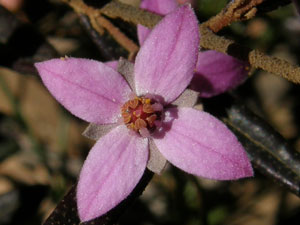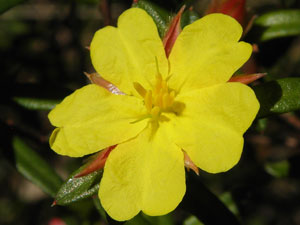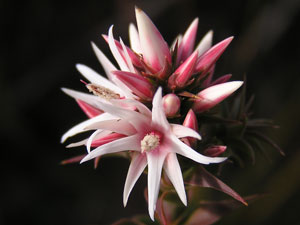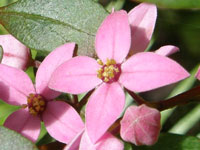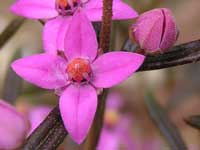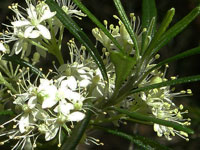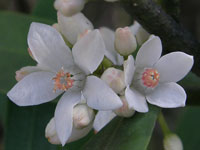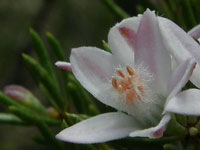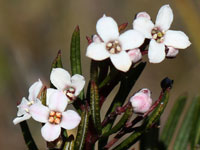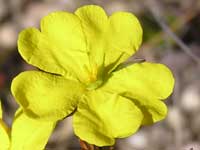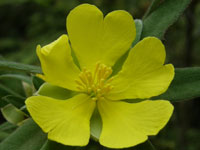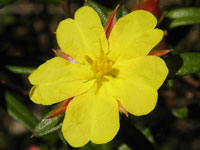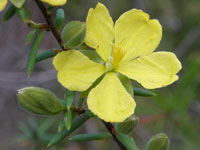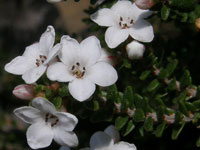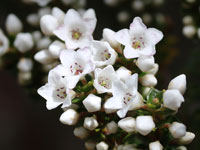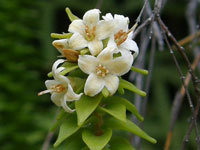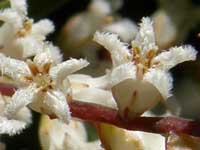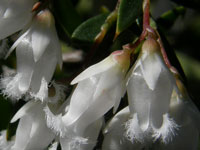We acknowledge the traditional custodians of the land on which these plants grow - the Darug and Gundungurra people - and pay respect to their Elders past, present and emerging.
Note: Images marked as LCNP were taken in the Lane Cove National Park.
There are an estimated 320 species of the Rutaceae family in Australia, about 45 of these are in the Blue Mountains.
The Dilleniaceae family is only represented by the Hibbertia genus in the Blue Mountains - but there are over 20 species.
The name Guinea Flower comes from the gold guinea coin.
A principal factor in identifying Guinea Flowers is the number and position of their stamens and carpels. For example the Blue Mountains Guinea Flower has about 16 yellow stamens and two green carpels.
Northern Heaths includes Rhododendrons and Azaleas.
There's over 60 species of the Ericaceae family in the Blue Mountains.
- Boronia genus
- Bronzy Boronia
- Deane's Boronia
- Fraser's Boronia
- Pale-pink Boronia
- Pinnate Boronia
- Small Leaved Boronia
- Sydney Boronia
- Cyanothamnus genus
- Sticky Boronia
- Stiff Boronia
- Eriostemon genus
- Pink Wax Flower
- Boronia deanei subsp. deanei
- Boronia floribunda
- Boronia fraseri
- Boronia ledifolia
- Boronia microphylla
- Boronia pinnata
- Boronia thujona
- Cyanothamnus anemonifolius subsp. anemonifolius
- Cyanothamnus rigens
- Eriostemon australasius
- Leionema dentatum
- Leionema lachnaeoides
- Leionema lamprophyllum subsp. orbiculare
- Phebalium squamulosum subsp. squamulosum
- Philotheca hispidula
- Philotheca myoporoides subsp. acuta
- Philotheca myoporoides subsp. myoporoides
- Philotheca obovalis
- Philotheca salsolifolia subsp. salsolifolia
- Zieria arborescens subsp. arborescens
- Zieria compacta
- Zieria covenyi
- Zieria laevigata
- Zieria pilosa
The fragrance from Boronias comes from the oil in the leaves - and this requires a sunny day for it to be released. Boronia essential oil comes from Western Australia’s Boronia megastigma (Brown Boronia).
There's an estimated 9 Boronia species in the Blue Mountains.
Unlike most members of the Rutaceae family, Boronias have 4 petals - as do Cyanothamnus species and Zierias. Boronia and Cyanothamnus species have 8 stamens - Zieria species have 4.
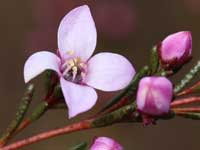
Deane's Boronia
Boronia deanei subsp. deanei
Its distinctive leaves are sessile and warty, and have an obtuse apex. They’re up to 10-12mm in length and are often appressed.
B. deanei subsp. acutifolia has not been recorded in the Blue Mountains and its leaves have an acute apex.
Here's another image and image.
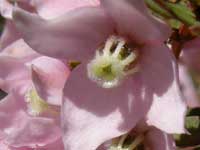
Pale-pink Boronia
Boronia floribunda
The eight hairy stamens give the impression that they are joined and look like a cage.
The leaves are pinnate with several leaflets and a mucro.
Here's another image and another.
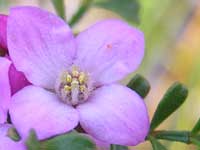
Small Leaved Boronia
Boronia microphylla
Its 5-8mm long leaves are pinnate - with half a dozen or so leaflet pairs.
Its petals overlap.
Here's another image.

Pinnate Boronia
Boronia pinnata
From observation its leaves also appear to be narrower and although acute lack a mucro.
It flowers from winter through summer.
Here's another image.
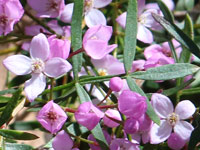
Bronzy Boronia
Boronia thujona
It also has a groove where its stems join the branch.
In 2020, 23 Boronia species were transferred into the Cyanothamnus genus. 4 of these are found in the Blue Mountains -
- B. anemonifolia now C. anemonifolius
- B. anethifolia now C. quadrangulus
- B. nana now C. nanus
- B. rigens now C. rigens
I am unable to see any obvious physical difference in the genera.
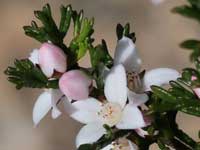
Sticky Boronia
Cyanothamnus anemonifolius
subsp. anemonifolius
The flowers are about 1cm across.
The leaves look sticky, but I can’t recall touching them.
Here's another image.
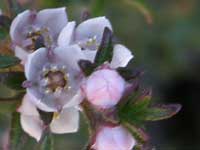
Stiff Boronia
Cyanothamnus rigens
Its tiny white flowers, that are usually not fully opened, and its mostly 3-foliolate leaves and hairy branchlets help identify it.
One needs to look closely to see the 8 stamens which characterise this species.
Here's another image and another.
Eriostemon genus
There's only one Eriostemon species in NSW. Several former Eriostemon species have been reclassified as Philotheca.
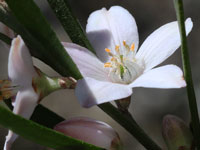
Pink Wax Flower
Eriostemon australasius
The colour varies from pale pink to red.
Here's another image showing pollinators.
Leionema genus
There are three Leionema species in the Blue Mountains, with several more further north in the Wollemi National Park.
Prior to 1998, all species within this genus were included in the genus Phebalium (Wikipedia).
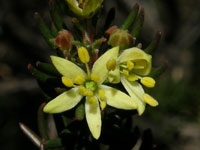
Leionema lachnaeoides
Its revolute (tightly recurved) leaves help identify it.
The plant shown here was lost in the Black Summer bushfires in 2019-20.
Here's another image and an image that shows a pollinator.
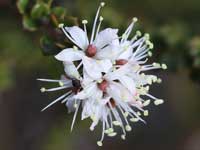
Shiny Phebalium
Leionema lamprophyllum
subsp. orbiculare
It grows in exposed ridges between Dunns Swamp and Newnes Plateau.
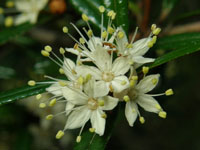
Forest Phebalium
Phebalium squamulosum
subsp. squamulosum
PlantNet warns the "Intergrades occur between many of the subspecies".
Here's another image.
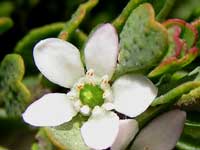
Wax Flower
Philotheca obovalis
The flowers are 20 mm wide and appear in Spring.
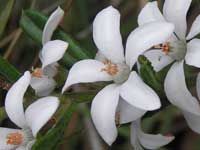
Rough Wax Plant
Philotheca hispidula
Previously known as Eriostemon hispidulus.
Here's a six petal flower.
Here's another image and another.
There are a dozen Zieria species in the Blue Mountains. They have 4 petals and 4 stamens.
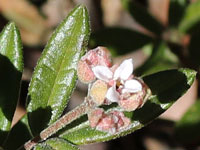
Coveny's Zieria
Zieria covenyi
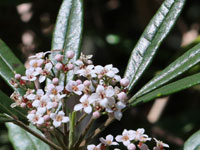
Forest Zieria
Zieria arborescens
subsp. arborescens
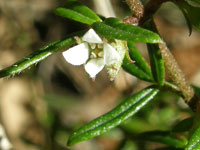
Hairy Zieria
Zieria pilosa
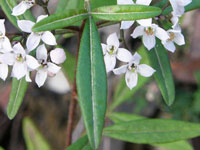
Zieria compacta
The leave's paler lower surface has short white hairs and oil glands.
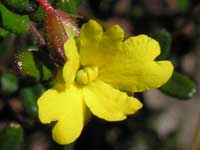
Brown Guinea Flower
Hibbertia rufa
It has 4 stamens and 2 carpels.
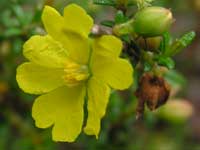
Thyme Guinea Flower
Hibbertia serpyllifolia
I imagine it gets its name from the similarity its leaves have to the younger leaves of the Common Thyme.
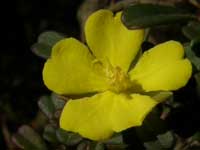
Leafy Guinea Flower
Hibbertia monogyna
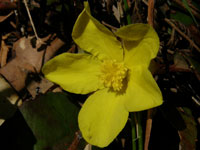
Golden Guinea Flower
Hibbertia scandens
The edges of its leaves can be either smooth or toothed - as shown on this image.
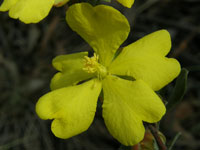
Grey Guinea Flower
Hibbertia obtusifolia
It has over 30 stamens and 3 carpels.
It's also known as the Hoary Guinea Flower.
- Epacris genus
- Blunt-leaf Heath
- Coral Heath
- Epacris apiculata
- Epacris browniae
- Epacris crassifolia
- Fuchsia Heath
- Keeled Heath
- NSW Coral Heath
- Swamp Heath
- Leucopogon genus
- Blunt Beard-heath
- Lance Beard-heath
- Leucopogon setiger
- Leucopogon fletcheri subsp. fletcheri
- Pink Beard-heath
- Small-leaved White Beard
- Other heath genera
- Daphne Heath
- Necklace Heath
- Peach Heath
- Pink Swamp Heath
- Prickly Broom Heath
- Red Five Corners
- Rock Sprengelia
- Snow Wreath
- Spanish Heath *
* Introduced species (weed)
- Brachyloma daphnoides subsp. daphnoides
- Dracophyllum secundum
- Epacris apiculata
- Epacris browniae
- Epacris crassifolia subsp. crassifolia
- Epacris microphylla
- Epacris obtusifolia
- Epacris paludosa
- Epacris pulchella
- Epacris reclinata
- Epacris rigida
- Erica lusitanica *
- Leucopogon ericoides
- Leucopogon fletcheri subsp. fletcheri
- Leucopogon lanceolatus var. lanceolatus
- Leucopogon microphyllus var. microphyllus
- Leucopogon muticus
- Leucopogon setiger
- Lissanthe strigosa subsp. strigosa
- Monotoca scoparia
- Sprengelia incarnata
- Sprengelia monticola
- Styphelia tubiflora
- Woollsia pungens
* Introduced species (weed)
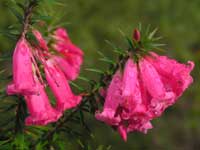
The Common Heath
Epacris impressa
It is not found as far north as the Blue Mountains.
There's over 20 species of the Epacris genus in the Blue Mountains.
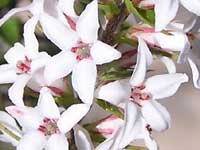
NSW Coral Heath
Epacris pulchella
It is also known as the Wallum Heath.
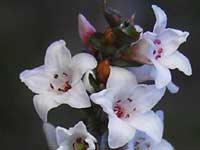
Coral Heath
Epacris microphylla
Here's another image.
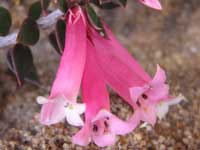
Fuchsia Heath
Epacris reclinata
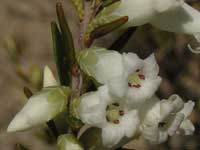
Blunt-leaf Heath
Epacris obtusifolia
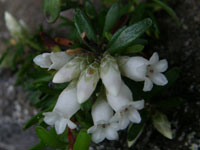
Epacris crassifolia
subsp. crassifolia
Its corolla (flower tube) is around 6mm in length.
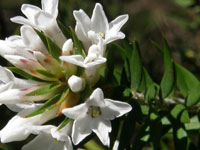
Swamp Heath
Epacris paludosa
It is also known as the Alpine Heath.
Leucopogons are easily recognised by their hairy mouths. There's 17 Leucopogon species in the Blue Mountains.
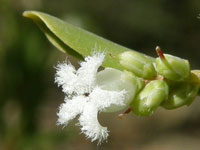
Blunt Beard-heath
Leucopogon muticus
Its flowers are borne on spikes.
Here's another image.
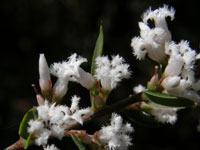
Pink Beard-heath
Leucopogon ericoides
Its recurved pungent leaves that are at 45° to the branch and more than two flowers on a short stalk is a good indicator.
Here's an image with a pollinator.
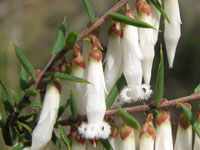
Leucopogon fletcheri
subsp. fletcheri
Its long pendulous flowers and recurved pungent leaves help identify it.

Small-leaved White Beard
Leucopogon microphyllus var. microphyllus
Its mass of flowers at the end of branches and parallel veins under its 6mm long leaves help identify it.
Here's another image.
There's a dozen or some other genera of the heath family in the Blue Mountains - most with only one or two species.

Pink Swamp Heath
Sprengelia incarnata
Here's another image.
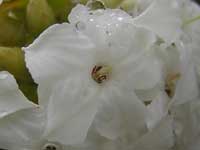
Snow Wreath
Woollsia pungens
Also recognised by the ripples on its petals.
This is the only species in this genus.
Here's another image.
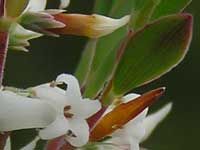
Daphne Heath
Brachyloma daphnoides subsp. daphnoides
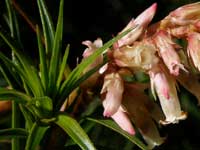
Necklace Heath
Dracophyllum secundum
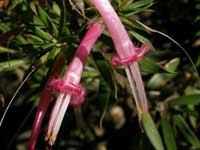
Red Five Corners
Styphelia tubiflora
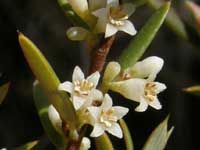
Prickly Broom Heath
Monotoca scoparia
Here's another image.
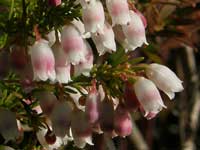
Spanish Heath
Erica lusitanica
Its leaves and whitish branches help identify it when it's not in flower.
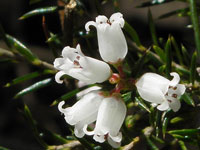
Peach Heath
Lissanthe strigosa subsp. strigosa

